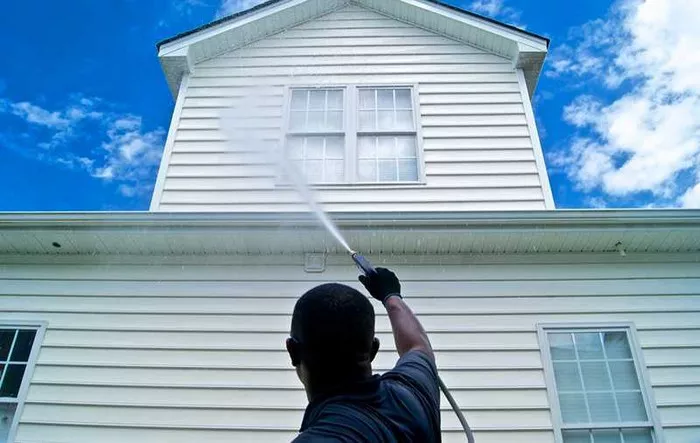Safety should always be the top priority when using power washers, especially when cleaning windows. Before starting any cleaning project, it’s crucial to ensure that you’re equipped with the appropriate protective gear. Wear safety goggles to shield your eyes from debris and water spray, and gloves to protect your hands from potential injuries. Additionally, make sure the power washer is used on a stable and secure surface to prevent accidents or injuries.
Choosing the Right Equipment
Selecting the proper power washer is essential for achieving optimal results when cleaning windows. For residential use, a medium-duty electric power washer is often recommended. These models offer adjustable pressure settings, allowing users to customize the pressure according to the specific cleaning needs of their windows. Electric power washers are also convenient for indoor use, as they produce less noise and fumes compared to gas-powered alternatives.
Preparing the Area
Before beginning the cleaning process, it’s important to prepare the area around the windows. Remove any obstacles or items that may obstruct your access to the windows or impede your movements while cleaning. Clear the surrounding area of furniture, potted plants, or any other objects that could be damaged by the high-pressure water. Additionally, cover nearby plants or delicate surfaces with tarps or drop cloths to protect them from overspray or potential damage.
Selecting the Correct Nozzle
Choosing the right nozzle is crucial for achieving effective and safe window cleaning with a power washer. For cleaning windows, a wide-angle nozzle with a spray angle of 25 or 40 degrees is typically recommended. These nozzles provide a balanced spray pattern that effectively cleans the surface without causing damage. Avoid using narrow-angle nozzles, as they may exert too much pressure and could potentially damage the windows or surrounding surfaces.
Adjusting Pressure Settings
Properly adjusting the pressure settings of the power washer is key to achieving optimal cleaning results while minimizing the risk of damage to the windows. Start by selecting a low to medium pressure setting, especially if you’re cleaning delicate or fragile surfaces such as glass windows. As a general rule, lower pressure settings are suitable for most window surfaces, while higher pressure may be necessary for removing stubborn stains or debris from exterior surfaces.
Techniques for Effective Cleaning
To ensure thorough and efficient cleaning, follow these step-by-step instructions:
1. Start at the top: Begin cleaning at the top of the window and work your way downwards. This allows gravity to help carry away dirt and debris as you clean.
2. Use overlapping strokes: Move the power washer in overlapping strokes to ensure complete coverage and thorough cleaning of the window surface.
3. Maintain a consistent distance: Keep the power washer nozzle at a consistent distance from the window surface to ensure even cleaning. A distance of approximately 12 to 18 inches is typically recommended.
4. Angle the spray appropriately: Angle the spray of the power washer slightly downwards to prevent water from seeping into the window frame or causing damage to the seals.
Rinsing and Drying
After cleaning the windows, it’s important to rinse away any remaining detergent or debris to prevent streaking or water spots. Thoroughly rinse the windows with clean water using the power washer, making sure to remove all traces of soap or cleaner. Once rinsed, use a squeegee or a soft cloth to dry the windows thoroughly, working from top to bottom in smooth, overlapping strokes. This will help achieve a streak-free finish and ensure that your windows sparkle and shine.
Safety Tips for Working at Heights
If you’re cleaning windows at height, it’s essential to take extra precautions to ensure your safety. Always use appropriate safety measures such as securing ladders or scaffolding to prevent falls or accidents. Make sure the ladder is placed on a stable surface and extend it sufficiently to reach the desired height without overreaching. Additionally, consider using safety harnesses or ropes for added security when working at elevated heights.
Maintenance and Storage
Proper maintenance and storage are essential for prolonging the life of your power washer and ensuring its continued effectiveness. After each use, thoroughly clean the power washer to remove any dirt, debris, or detergent residue that may accumulate. Pay special attention to the nozzle and spray wand, as these areas are prone to clogging. Once cleaned, store the power washer in a dry and secure location, away from extreme temperatures or moisture. Regular maintenance, such as checking for leaks or worn parts, will help prevent costly repairs and ensure that your power washer remains in optimal condition.
Troubleshooting
Despite your best efforts, you may encounter some common issues or challenges while cleaning windows with a power washer. Here are some tips to help you overcome them:
1. Streaking: If you notice streaks or smudges on the windows after cleaning, it may be due to residual detergent or debris. Rinse the windows again with clean water to remove any remaining soap or grime, and dry them thoroughly with a squeegee or soft cloth.
2. Water spots: Water spots can occur if the windows are not dried properly after cleaning. Use a squeegee or a soft, absorbent cloth to remove excess water from the windows, ensuring a streak-free finish.
3. Uneven cleaning: If you’re experiencing uneven cleaning results, check the pressure settings and nozzle angle of the power washer. Adjust as needed to achieve a consistent spray pattern and even coverage across the window surface.
Conclusion
By following these safety precautions and guidelines, you can effectively clean your windows using a power washer, achieving sparkling results while minimizing the risk of damage or injury. With the right equipment, techniques, and maintenance practices, you can enjoy clean, clear windows that enhance the appearance and value of your home.

